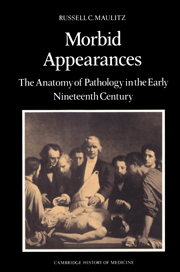Book contents
- Frontmatter
- Contents
- Dedication
- Preface
- Introduction: Ouverture: Bichat's head
- PART ONE PARIS
- PART TWO CHANNEL CROSSING
- 5 The context of English pathology, 1800–1830
- 6 Channel crossing
- PART THREE LONDON
- Conclusion: A language of morbid appearances
- Appendix: Transcription and translation of Figure 1.1
- Notes
- Selected bibliography
- Index
5 - The context of English pathology, 1800–1830
Published online by Cambridge University Press: 22 September 2009
- Frontmatter
- Contents
- Dedication
- Preface
- Introduction: Ouverture: Bichat's head
- PART ONE PARIS
- PART TWO CHANNEL CROSSING
- 5 The context of English pathology, 1800–1830
- 6 Channel crossing
- PART THREE LONDON
- Conclusion: A language of morbid appearances
- Appendix: Transcription and translation of Figure 1.1
- Notes
- Selected bibliography
- Index
Summary
THE PROFESSIONAL SETTING
The intellectual and professional circumstances of English medicine in the late Georgian period were dramatically different from those across the Channel. That this was so does not necessarily reinforce the invidious comparisons many English observers at the time made at their own countrymen's expense. Indeed, the truth of the matter was that by the late eighteenth century English hospital planning, medical reform, and surgical anatomy teaching all had had significant impacts on their continental counterparts. Even so, the medical communities of England and Scotland, as the age of Napoleon drew to a close and its members began more broadly to engage the outside world, was in a rather fractious state. In reengaging, English medicine produced a suite of new professional structures. Those new structures, institutions, societies, and a number of other enterprises, including a rash of new medical journals, jostled one another and their ancient predecessors, while their various patrons and designers pursued a variety of interests. Among such interests were the tasks of fostering pathological anatomy and certain other elements, notably chemistry, of an emerging nineteenth-century scientific culture.
The desire to bring pathological anatomy, French-style or otherwise, into medical education and medical practice must be understood against the backdrop of the professional changes that were sought by the new men and their organizations.
- Type
- Chapter
- Information
- Morbid AppearancesThe Anatomy of Pathology in the Early Nineteenth Century, pp. 109 - 133Publisher: Cambridge University PressPrint publication year: 1987

